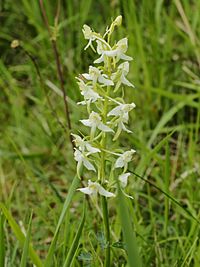East Wood, Tidenham facts for kids
East Wood is a special nature reserve in Gloucestershire, England. It's a place where nature is protected. This reserve is made up of two smaller areas. Together, they cover about 0.82 hectares. That's roughly the size of two football fields! It's part of a bigger woodland area also called East Wood.
The land for this reserve was rented from the Forestry Commission in 1986. The Gloucestershire Wildlife Trust now looks after it. East Wood is known as a Key Wildlife Site (KWS). This means it's very important for local plants and animals.
Contents
Where is East Wood Located?
This nature reserve is found on the southern edge of the Forest of Dean. It's also east of the beautiful Wye Valley. The reserve has two small areas that were once cleared. These spots are about 200 meters apart. They are located between the villages of Tidenham and Hewelsfield.
What is the Habitat Like?
The ground here is made of a type of rock called Carboniferous Drybrook limestone. In the 1980s, soil and bushes were removed from these two areas. This helped to show the limestone rock underneath. Clearing the land helps special plants grow. These plants need open, rocky ground to thrive. The southern part of East Wood is an ancient woodland. This means it has been a forest for a very long time. Because of this, many different kinds of plants grow there.
Amazing Plants of East Wood
East Wood is home to many wonderful plant species. You can see how rich the reserve is by the plants that grow there.
Spring Flowers
In spring, you might spot beautiful flowers like Columbine and Greater Butterfly-orchid. There are also Wood Anemone and pretty Bluebells. Other spring blooms include Yellow Archangel, Primrose, and Early Purple Orchid. You might also find Cowslip and the Early Dog-violet.
Summer Blooms
When summer arrives, new flowers appear. These include Common Milkwort and Oxeye Daisy. You can also see Common Knapweed and the Bulbous Buttercup. Sometimes, the rare Martagon Lily blooms here. Other plants like Foxglove and Rosebay Willowherb are also recorded.
Ferns and Trees
Between the rocks, you can find ferns like Black Spleenwort and Hart's-tongue Fern. The west side of the reserve has some Beech trees. You'll also find other trees and shrubs. These include Hawthorn, Hazel, Dogwood, and Broom. There are also old stumps of Oak, Ash, Field Maple, and Birch trees. These stumps show where trees were cut long ago.
A Bit of History
A very old tree called the King Yew is near the reserve. It is thought to be between 400 and 500 years old! This amazing tree is located a few hundred meters east of the reserve. You can find it in Woolaston Wood.
Looking After the Reserve
The open limestone areas need regular care. This helps to keep them clear of plants that grow too fast. For example, Bramble can quickly take over. The reserve managers are making these open areas bigger. They also make sure there's a smooth change from the open ground to the darker conifer forest. This helps different plants and animals to live there.
Enjoying Walks in the Area
There is a special guide that describes walks in the Wye Valley. These walks are great for seeing wildlife and enjoying amazing views. The guide includes information about famous paths like Offa's Dyke Path and the Gloucestershire Way. It also tells you about interesting places nearby. These include Devil's Pulpit (Tintern) and Lippets Grove. You can also learn about Caswell Woods SSSI, Oakhill Wood, and Ridley Bottom nature reserve.


